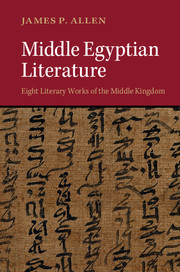Book contents
- Frontmatter
- Contents
- Introduction
- Text 1 The Story of the Shipwrecked Sailor
- Text 2 The Story of Sinuhe
- Text 3 The Loyalist Instruction
- Text 4 The Instructions of Kagemni's Father and Ptahhotep
- Text 5 The Discourses of the Eloquent Peasant
- Text 6 The Debate between a Man and His Soul
- Text 7 The Herdsman's Tale
- Text 8 Hymns to Senwosret III
- Consecutive Translations
Introduction
Published online by Cambridge University Press: 05 January 2015
- Frontmatter
- Contents
- Introduction
- Text 1 The Story of the Shipwrecked Sailor
- Text 2 The Story of Sinuhe
- Text 3 The Loyalist Instruction
- Text 4 The Instructions of Kagemni's Father and Ptahhotep
- Text 5 The Discourses of the Eloquent Peasant
- Text 6 The Debate between a Man and His Soul
- Text 7 The Herdsman's Tale
- Text 8 Hymns to Senwosret III
- Consecutive Translations
Summary
This book was written to serve as a companion volume to the third edition of my Middle Egyptian grammar. It provides editions of both well-known and lesser-known texts for students to apply their knowledge of the language to the exercise of working with real Middle Egyptian compositions.
Besides that pedagogic purpose, the book has two other goals: to make the texts more readily available than is currently the case, and to present them in a fashion as close to the original as possible. All but one of the originals are written in hieratic on papyrus. Unlike other editions, this book presents hieroglyphic transcriptions in the same orientation as the originals: right to left, and in columns as well as lines.
Each text is presented in hieroglyphs, transliteration, translation, and textual notes. The notes deal with matters of both grammar and interpretation; the former are keyed to the relevant sections of my grammar, and the latter sometimes cross-reference the essays in that book. Grammatical notes are extensive for the first text, for which every form and construction is discussed. They diminish in frequency in subsequent texts, as students (ideally) become more proficient in working with the language.
Five of the texts are those that any student of Middle Egyptian should read: the stories of the Shipwrecked Sailor and Sinuhe, the instructions of Kagemni's father and Ptahhotep, the discourses of the Eloquent Peasant, and the Debate between a Man and His Soul. The other three were chosen to complement these: the Loyalist Instruction, to illustrate the attitude toward the king that underlies the story of Sinuhe; the tale of the Herdsman, because it is on the same papyrus as the Debate; and the Hymns to Senwosret III, to exemplify the genre of hymns.
The great anthologies of Egyptian literature in translation contain many more works than these, but the compositions here have been singled out for two more reasons. First is the question of genre. Egyptian literature can be divided into two categories.
- Type
- Chapter
- Information
- Middle Egyptian LiteratureEight Literary Works of the Middle Kingdom, pp. 1 - 8Publisher: Cambridge University PressPrint publication year: 2014

